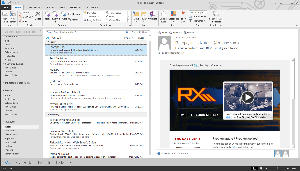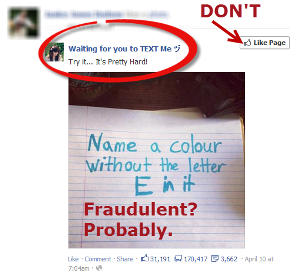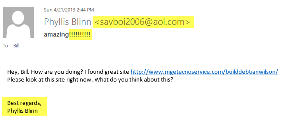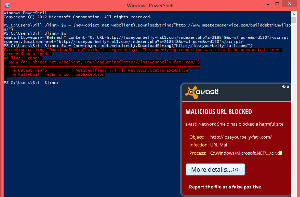Choosing Usability over Versatility
If you've been following TechByter Worldwide and, before that, Technology Corner on WTVN Radio, you have have heard me talk about The Bat many times. It's probably the world's most versatile e-mail application, capable of doing just about anything. You've heard me scoff at Microsoft Outlook more than once, too. So you might be more that slightly surprised to learn that I'm now using Outlook 2013 instead of The Bat. There is, of course, a story behind this.
Well before 2000, I had tried version 1 of The Bat, concluded that it was a promising application but that it needed more work, and continued using Eudora. In May of 2000, I wrote that I had rediscovered The Bat (then version 2) and that I strongly recommended it. That's been the story with version 3, 4, and 5 but recently the frustration caused by a seemingly small bug became so significant that I went looking for an e-mail program for the first time in 13 years.
What I found was surprising. Apparently "state of the art" for most e-mail applications was frozen in time around 2003. This is understandable because most e-mail programs are now free (open source) such as Thunderbird or Pegasus or no-extra-charge (included with something else) such as Outlook. The Bat is one of the few e-mail programs that's not free, but it's inexpensive, and I found a program called Postbox that's based on Thunderbird code and is cheap.
Minor Issue Becomes a Deciding Factor
In the early 1980s, Jack Fitzgerald was the program director at WTVN Radio. At a staff meeting one day he talked about the importance of sweating the small stuff. The concept was easy to grasp: In any competitive activity, the factor that decides the winner is often small and overlooked. This could by an Olympic event in which the difference between 1st place and 20th place is less than half a second, a football game that might be decided by a distance of a few inches, or a radio station might lose ratings by making what seems like a small change.
 Fitzgerald's message was that most of the major players in any endeavor do all the big things right and that what differentiates them are the small things. The least important consideration suddenly becomes the most important consideration.
Fitzgerald's message was that most of the major players in any endeavor do all the big things right and that what differentiates them are the small things. The least important consideration suddenly becomes the most important consideration.
And, in the end, so it was in the decision between The Bat and Outlook.
Several months ago, The Bat developed an annoying habit of converting all of my text to 9-point Courier in replies to messages as soon as I pressed Enter. This rarely occurred in new messages but sometimes replies were converted, or partially converted, to 9-point Courier before I typed anything. Most disconcerting were those instances in which part of my signature block were converted to Courier while the rest was left alone. My choices were to send the ugly message (what I did when I was in a hurry) or to select the entire message, change the type face and then change the type size. Because of a second bug, the change actually involved changing both the face and the size twice.
I reported the problem and RIT Labs indicated that it is a known bug. If something was being done to correct the problem, I would wait, but that seems not to be the case.
So I spent one weekend looking at various e-mail applications and most of them seemed to be stuck in the early 2000s. The interfaces had a distinct turn-of-the-century appearance and the feature set hadn't changed much. Mozilla's Thunderbird and Postbox, which is based on Thunderbird, looked promising but Thunderbird still has too many bugs and deficiencies and Postbox retains all of Thunderbird's problems while adding its own. I also looked at DreamMail, Mulberry, FoxMail, Alpine (which looks like something from the late 1980s), and a few others. Some were on the computer for less than 10 minutes. Others survived minimal testing before being deleted.
So I looked at Outlook. The appearance is certainly modern but getting it set up was almost a show stopper. By default Outlook wants to place its data files on drive C but I'm not about to waste valuable solid-state-drive space with e-mail. After more than an hour and numerous Google queries, I finally managed to convince Outlook to place its files on drive D.
Filtering Down
 One of the most powerful features The Bat has to offer is its ability to filter messages on various combinations of conditions. Outlook has message filtering, too, but it's not nearly as robust as The Bat's. Still, after working with the filters for an afternoon, I concluded that the capability is good enough.
One of the most powerful features The Bat has to offer is its ability to filter messages on various combinations of conditions. Outlook has message filtering, too, but it's not nearly as robust as The Bat's. Still, after working with the filters for an afternoon, I concluded that the capability is good enough.
No method exists by which I can import The Bat's filters to Outlook. Believe me, I looked. I have written a lot of filters for The Bat and rewriting all of them for Outlook isn't something I'm looking forward to. Doing so, however, might result in a better series of filters. After all, I should have a better idea what I'm doing than I did in 2002.
Importing Files from The Bat
Initially, I thought that there was no way to move messages from The Bat to Outlook. Both programs have their own proprietary file formats. The Bat doesn't have an output to Outlook format option and Outlook doesn't have an import from The Bat option. I had resigned myself to keeping The Bat on the computer to review old messages much as I had retained Eudora when I started using The Bat.
That turned out not to be necessary.
I found Aid4Mail from Fookes Software in Switzerland. I could have bought the $20 2-week license but decided that I might continue to find messages that would need to be migrated for the next year or so. For $30, I acquired a 1-year license.
This is a remarkable program that allows the buyer to switch from nearly any e-mail application to nearly any other e-mail application. If you're thinking about switching e-mail programs, you'll want Aid4Mail because it can accept files from any of these applications: Microsoft Exchange, Outlook Personal Storage files and MSG files, Outlook Express versions 4 through 6, Windows Live Mail, Windows Mail, IMAP accounts, Webmail services that offer IMAP access (such as Gmail, Yahoo Mail, AOL Mail, FastMail, GMX Mail, Outlook Live, etc), Mozilla Thunderbird, SeaMonkey, Netscape, Apple Mail message files, Qualcomm Eudora, Eudora OSE, Macintosh Eudora, Generic, EML message files, MHT Web Archive files, Pegasus, The Bat!, PocoMail, Barca, FoxMail through version 6.5, Opera, Calypso and Courier archive files, Forte Agent, Pine, PMMail message files, Maildir folders, MSN Mail v8, Mailbag Assistant, E-mail Examiner, and Aid4Mail ZIP archives.
Aid4Mail can then export the results to any of these programs: Microsoft Exchange through Outlook/MAPI or IMAP, Outlook Personal Storage files, Outlook MSG files – only if source mail comes from Microsoft Exchange or Outlook files, Windows Live Mail, Windows Mail, IMAP accounts, Webmail services that offer IMAP access (such as Gmail, Yahoo Mail, AOL Mail, FastMail, GMX Mail, Outlook Live, etc), Mozilla Thunderbird, SeaMonkey, Eudora OSE, Netscape, PocoMail, Barca, Generic, EML message files, MHT Web Archive files (linked from an HTML index page or an MS Excel Workbook file), MHT files with tab-delimited data file for import into a database, Adobe Acrobat PDF files, Aid4Mail ZIP archives.
Aid4Mail is available from Fookes Software.
Macros and More
The Bat's ability to replace a single key word with paragraphs (or pages) of text has been an important feature since 2000 when I discovered it. Plug-ins exist to extend this kind of capability to Outlook, but I already use MacroExpress and the latest version of this application allow it to paste in formatted text.
I like The Bat's ability to display the entire contents of a message (from the headers through all parts of a multi-part message) with a single key press—F9 and Outlook has nothing to compare. It's possible to view the headers, but to do so it's necessary to open the message, not just have it open in the preview window. Then you have to drill down through a multi-level menu and peek through what is effectively a key-hole that shows only the headers. It's better than nothing but you'd think Microsoft could do better.
A Microsoft Technet blogger suggested that it's possible to view the full text through the keyhole but it requires a Registry modification. Beyond that, the Registry modification post was written in 2004 and applied to Outlook 2003 and I could find no similar references for versions 2007, 2010, or 2013 and when I modified the key to address the analogous section of the Outlook 2013 Registry entry, there was still no change. So apparently the best Microsoft can do is to show the routing headers and then only with some difficulty.
Overall ...
Outlook is no longer the security threat that it was a dozen years ago but it's still the largest, and therefore most attractive, target. It doesn't offer features that I will miss but it also doesn't include certain annoyances that I won't miss. Outlook alone is capable of performing all critical e-mail-related tasks and the judicious use of other applications and add-ons will make it possible for Outlook to perform some tricks that it can't manage natively.
Outlook's direct connection to calendar and organizer functions, plus the richly-featured built-in contact function are all very welcome, as is the connection to OneNote and Outlook's own built-in notes feature.
That's not to say I won't miss The Bat, but progress has been slow and there's no indication that anything will change anytime soon. So without batting an eye, I guess that I have to say the Outlook is bright.
Oh ... sorry about that.
Annoying Scams from Facebook Creeps
"Type '1' in Comments and see what happens." Posts such as this make me want to put on my best Lewis Black attitude and say something like this: "Nothing will happen, you moron! Do you have any idea how Facebook works? If you did, you'd know that typing '1' won't make anything happen. But you know that don't you because something will happen: The idiots who follow your advice will make money for you."
So how does this work?
Maybe you've seen the post that features "my sister Mallory", in which someone claims that his or her "sister", Mallory, has Down Syndrome and doesn't think she's beautiful. It asks viewers to click the Like option to show her that she is.
Who could resist? And what could be the harm?
- Harm #1: The picture was that of a girl from Australia. It had been stolen and used without the knowledge of the girl's family. In other words, the poster was not the girl's sister.
- Harm #2: Clicking "Like" is putting money in some creep's pocket.
Here's how the scam works: The creep creates a page. It's easy and takes maybe 5 minutes to set up. This page is then used to share images such as that of "Mallory" or maybe of a kid that says his parents will buy him something special if he gets a million Likes in the next week. Internet rubes then click to visit the page, like it, and share the image. Within a few days, this fake Facebook site has 50,000 or 100,000 likes.
Then the creep goes for the payoff: The page will be peddled to some less than ethical business that wants a ready-made page with 50,000 or 100,000 followers.
By the way, the Brooklyn Bridge isn't for sale, either.
Likes, shares, and comments all contribute to what Facebook calls a page's Edge Rank. Higher rankings mean that the page will be included in more feeds. If you see too much garbage in your feed, it's because people who don't know any better react to these fake posts. The only way to make them go away is to ignore them. Or, better still, report them to Facebook. If enough people report fraudulent pages, Facebook will take the page down.
How Big is the Problem?
Facebook admits having a lot of fake users. About 83 million, in fact. Some of these have been created by creeps such as the one that put up the fake "Mallory" page. Some people have even reported that their pages have been copied by people who represent themselves as the person whose information they've stolen.
 Really, it's not so hard to identify fraudulent messages.
Really, it's not so hard to identify fraudulent messages.
Do you really think that Whole Foods will give a $500 gift card to anyone who likes this fake link? American Airlines isn't giving away flights, either. And neither is any other airline.
 Nobody has thousands of "unsealed Iphones" that they can't sell. If an electronic device of any sort fails or is returned, it will be sold by an organization such as W00t.
Nobody has thousands of "unsealed Iphones" that they can't sell. If an electronic device of any sort fails or is returned, it will be sold by an organization such as W00t.
There is a huge market for refurbished goods and they are not given away because they can't be sold.
 Here's one from "Waiting for you to TEXT me". Does anyone really think that this is a legitimate site?
Here's one from "Waiting for you to TEXT me". Does anyone really think that this is a legitimate site?
Well, yes. The creeps who launched this already have nearly 71,000 likes.
A fool is not born every minute. It happens much more frequently than that.
 And, no, Bill Gates will not send you $5000.
And, no, Bill Gates will not send you $5000.
 If you want to like, comment, or share, pick a worthwhile organization.
If you want to like, comment, or share, pick a worthwhile organization.
The image at the right is from the Columbus Zoo. Columbus and San Diego are two of the best zoos in the nation. Fortunately, I live within easy driving distance of the Columbus Zoo so I frequently share posts from there.
PS ... Have you heard? They took "gullible" out of the dictionary!
Short Circuits
An Alarming Improvement in Malware-Laden Spam
Almost overnight, the quality of teaser spams has improved dramatically. You're probably familiar with messages that claim to be from someone you know and include nothing more than a website URL. Most people don't send messages like that. Instead, they send a message that says something about the link. And now the bad guys have figured out how to do that.
 Take a look at this message that claims to be from my wife. There are 3 obvious indications that the message is not from her: First, she doesn't have an AOL e-mail address. Second, it's unlikely that she would use even 3 exclamation points in a row and certainly not 10. Third, as best I can remember, she has never closed an e-mail message to me with "best regards" and her full name. Oh, and there's also this: The message was written at 2:44pm on Sunday, but I received it around 1:50pm, so unless my wife found a way to write this message in the future and send it back to me in the past, it's not from her. There is one other clue: At the time, she was out shopping and her phone doesn't send e-mail.
Take a look at this message that claims to be from my wife. There are 3 obvious indications that the message is not from her: First, she doesn't have an AOL e-mail address. Second, it's unlikely that she would use even 3 exclamation points in a row and certainly not 10. Third, as best I can remember, she has never closed an e-mail message to me with "best regards" and her full name. Oh, and there's also this: The message was written at 2:44pm on Sunday, but I received it around 1:50pm, so unless my wife found a way to write this message in the future and send it back to me in the past, it's not from her. There is one other clue: At the time, she was out shopping and her phone doesn't send e-mail.
The message claims to have been sent from AOL:
Received: from localhost (unknown [186.46.229.142])
(using TLSv1 with cipher DHE-RSA-AES256-SHA (256/256 bits))
(No client certificate requested)
by mtaout-da04.r1000.mx.aol.com (MUA/Third Party Client Interface) with ESMTPSA id 5E164E0000A0
for <one_of_my_addresses_here@blinn.com>; Sun, 21 Apr 2013 13:33:21 -0400 (EDT)
 The IP address that my mail server received the message from is 64.12.81.148 and that is AOL.
The IP address that my mail server received the message from is 64.12.81.148 and that is AOL.
I wondered what this game was so I used a Windows Power Shell procedure to load the target website into a variable: $w = (new-object net.webclient).DownloadString("http://www.redacted_URL.com/builddebtianwilson/") and found, as expected, that this site would simply redirect my browser elsewhere: <meta http-equiv="Refresh" content="0; URL=http://redacted_URL.com/indexer.php?a=218848&c=wl_pure&s=d120"><script
>parent.location.href='http://redacted_URL.com/indexer.php?a=218848&c=wl_pure&s=d120'</script>
 When I used the same PowerShell procedure to load the site my browser would have been sent to, the result was a warning and Avast blocked the site.
When I used the same PowerShell procedure to load the site my browser would have been sent to, the result was a warning and Avast blocked the site.
It's increasingly important that we all confirm that the claimed sender of a message is the actual sender of the message and that any links in the message have been sent intentionally by the person you know. In most cases, a careful reading of any message, along with inspection of the e-mail address, signature, and other parts of the message should serve to identify malware laden messages. If you're not certain, there's nothing wrong with asking the apparent sender if the message is legitimate.
Twitter Needs to Establish a Security Perimeter
A fake twitter post this week, claiming to be from the Associated Press, said that there had been an explosion at the White House and that the president had been injured. There had, of course, been no explosion, but for a few minutes the stock market wasn't aware of that.
In the next few minutes automated trading routines dumped $134 billion worth of stocks. So the computers that run Wall Street are just as gullible as human investors.
And the trouble with the computers that do the trading do so with astonishing speed.
Markets recovered quickly, but the incident once again highlighted the dangers of allowing computers to do all the heavy lifting. Before massive trades are completed solely by computers, perhaps it might be wise to include a bit of human oversight.
Twitter's security procedures are among the weakest on the Internet and the incident also highlights the need for the organization to establish more robust controls.
A group that calls itself the Syrian Electronic Army claims that it hacked the account and posted the fake message. The FBI is investigating because that single tweet and the misinformed trading that followed it caused the Dow to drop by more than 140 points, or about 1%, in 2 minutes.
Speed may be good, but accuracy is almost always better.
Another Magazine Headed for Online Only
Vibe isn't Newsweek. In fact, it's likely that most people who read TechByter Worldwide or listen to the podcast have never heard of Vibe. SpinMedia has purchased Vibe, which has been around for more than 2 decades and is likely to drop the print edition in favor of a Web-based magazine.
Vibe's topic is R&B and hip-hop music. This week SpinMedia bought the rights to the magazine and to the websites Vibe.com and Vibevixen.com. In many ways, it's old home week because Vibe and Spin Ventures were once part of the same company.
SpinMedia used to be called Buzz Media and it already owns or works with a lot of popular sites that attract younger visitors who are interested in music and other aspects of pop culture.
Why is Vibe's future likely to be digital only? Buzz Media bought Spin a little less than a year ago and before you could say "45 RPM", Spin stopped being a print publication. Buzz (as in "buzz saw") dropped about 1/3 of the publication's staff but said that the publication might be back someday. Since then, website traffic has increased substantially.
Check out the history: Quincy Jones and Time Warner worked together to develop Vibe as a magazine when the Internet was still far from ubiquitous and the Web hadn't yet been invented. That was 1992. Advertising revenue dropped following the great recession that started in 2008 and the magazine shut down in 2009. Private investors brought it back almost immediately.
At the end of its print life, Vibe sold about 300 thousand issues per month. Vibe’s sites, on the other hand, see about 1.4 million visitors every month. You see where the future lies.
